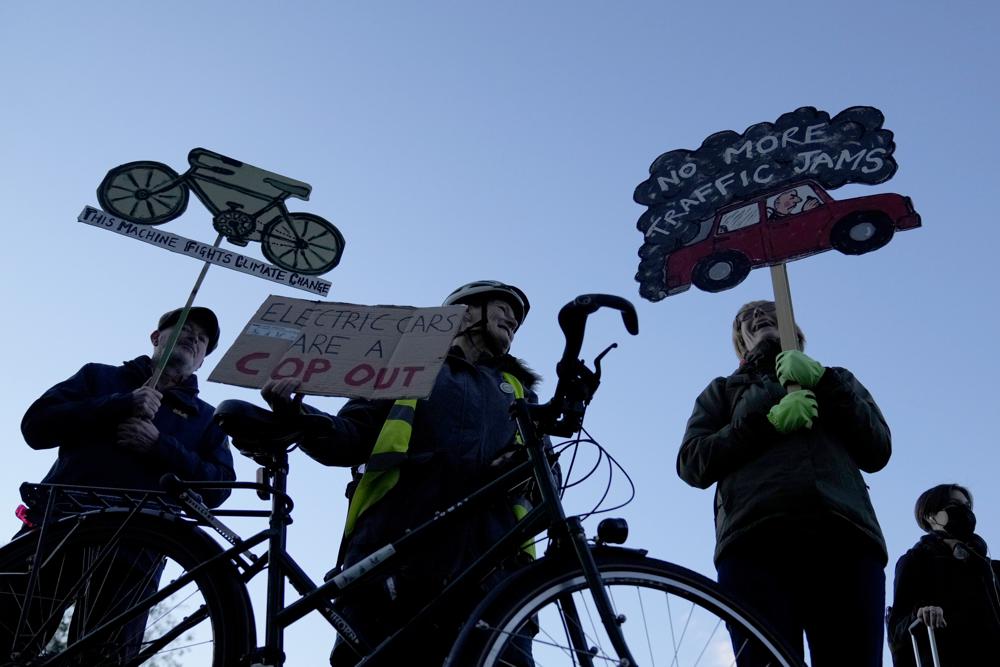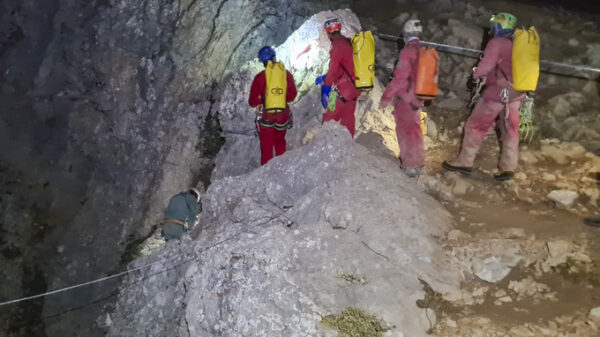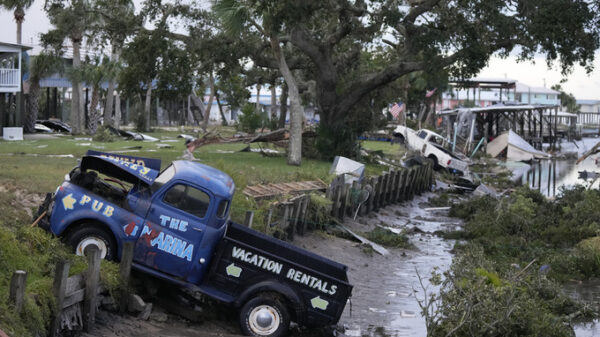People take part in a pro-cycling demonstration outside the SEC (Scottish Event Campus) venue for the COP26 U.N. Climate Summit, in Glasgow, Scotland, Wednesday, Nov. 10, 2021. The U.N. climate summit in Glasgow has entered its second week as leaders from around the world, are gathering in Scotland’s biggest city, to lay out their vision for addressing the common challenge of global warming. (AP Photo/Alastair Grant)
GLASGOW, Scotland (AP) — Governments are poised to express “alarm and concern” about how much Earth has already warmed and encourage one another to end their use of coal, according to a draft released Wednesday of the final document expected at U.N. climate talks.
The early version of the document circulating at the negotiations in Glasgow, Scotland, also impresses on countries the need to cut carbon dioxide emissions by about half by 2030 — even though pledges so far from governments don’t add up to that frequently stated goal.
In a significant move, countries would urge one another to “accelerate the phasing out of coal and subsidies for fossil fuels” in the draft, though it has no explicit reference to ending the use of oil and gas. There has been a big push among developed nations to shut down coal-fired power plants, which are a major source of heat-trapping gases, but the fuel remains a critical and cheap source of electricity for countries like China and India.
While the language about moving away from coal is a first and important, the lack of a date when countries will do so limits the pledge’s effectiveness, said Greenpeace International Director Jennifer Morgan, a long-time climate talks observer.
“This isn’t the plan to solve the climate emergency. This won’t give the kids on the streets the confidence that they’ll need,” Morgan said.
The draft doesn’t yet include full agreements on the three major goals that the U.N. set going into the negotiations — and may disappoint poorer nations because of a lack of solid financial commitments from richer ones. The goals are: for rich nations to give poorer ones $100 billion a year in climate aid, to ensure that half of that money goes to adapting to worsening global warming, and the pledge to slash emissions that is mentioned.
The draft does provide insight, however, into the issues that need to be resolved in the last few days of the conference, which is scheduled to end Friday but may push past that deadline. Still, a lot of negotiating and decision-making is yet to come since whatever emerges from the meetings has to be unanimously approved by the nearly 200 nations attending.
The draft says the world should try to achieve “net-zero (emissions) around mid-century.” That means requiring countries to pump only as much greenhouse gas into the atmosphere as can be absorbed again through natural or artificial means.
It also acknowledges “with regret” that rich nations have failed to live up to the climate aid pledge.
Poorer nations, which need financial help both in developing green energy systems and adapting to the worst of climate change, are angry that the promised aid hasn’t materialized.
“Without financial support little can be done to minimize its debilitating effects for vulnerable communities around the world,” Mohammed Nasheed, the Maldives’ parliamentary speaker and the ambassador for a group of dozens of countries most vulnerable to climate change, said in a statement.
He said the draft fails on key issues, including the financial aid and strong emission cuts.
“There’s much more that needs to be done on climate finance to give developing countries what they need coming out of here,” said Alden Meyer, a long-time conference observer, of the European think-tank E3G.
The document reaffirms the goals set in Paris in 2015 of limiting warming to “well below” 2 degrees Celsius (3.6 degrees Fahrenheit) since pre-industrial times, with a more stringent target of trying to keep warming to 1.5 degrees Celsius (2.7 degrees Fahrenheit) preferred because that would keep damage from climate change “much lower.”
Highlighting the challenge of meeting those goals, the document “expresses alarm and concern that human activities have caused around 1.1 C (2 F) of global warming to date and that impacts are already being felt in every region.”
Small island nations, which are particularly vulnerable to warming, worry that too little is being done to stop warming at the 1.5-degree goal — and that allowing temperature increases up to 2 degrees would be catastrophic for their countries.
“For Pacific (small island states), climate change is the greatest, single greatest threat to our livelihood, security and wellbeing. We do not need more scientific evidence nor targets without plans to reach them or talking shops,” Bruce Bilimon, the Marshall Islands’ health and human services minister, told fellow negotiators Wednesday. “The 1.5 limit is not negotiable.”
Separate draft proposals were also released on other issues being debated at the talks, including rules for international carbon markets and the frequency by which countries have to report on their efforts.
The draft calls on nations that don’t have national goals that would fit with the 1.5- or 2-degree limits to come back with stronger targets next year. Depending on how the language is interpreted, the provision could apply to most countries. Analysts at the World Resources Institute counted that element as a win for vulnerable countries.
“This is crucial language,” WRI International Climate Initiative Director David Waskow said Wednesday. “Countries really are expected and are on the hook to do something in that timeframe to adjust.’’
Greenpeace’s Morgan said it would have been even better to set a requirement for new goals every year.
In a nod to one of the big issues for poorer countries, the draft vaguely “urges” developed nations to compensate developing countries for “loss and damage,” a phrase that some rich nations don’t like. But there are no concrete financial commitments.
“This is often the most difficult moment,” Achim Steiner, the head of the U.N. Development Program and former chief of the U.N.’s environment office, said of the state of the two-week talks.
“The first week is over, you suddenly recognize that there are a number of fundamentally different issues that are not easily resolvable. The clock is ticking,” he told The Associated Press.
“This isn’t the plan to solve the climate emergency. This won’t give the kids on the streets the confidence that they’ll need,” Morgan said.
The draft doesn’t yet include full agreements on the three major goals that the U.N. set going into the negotiations — and may disappoint poorer nations because of a lack of solid financial commitments from richer ones. The goals are: for rich nations to give poorer ones $100 billion a year in climate aid, to ensure that half of that money goes to adapting to worsening global warming, and the pledge to slash emissions that is mentioned.
The draft does provide insight, however, into the issues that need to be resolved in the last few days of the conference, which is scheduled to end Friday but may push past that deadline. Still, a lot of negotiating and decision-making is yet to come since whatever emerges from the meetings has to be unanimously approved by the nearly 200 nations attending.
The draft says the world should try to achieve “net-zero (emissions) around mid-century.” That means requiring countries to pump only as much greenhouse gas into the atmosphere as can be absorbed again through natural or artificial means.
It also acknowledges “with regret” that rich nations have failed to live up to the climate aid pledge.
Poorer nations, which need financial help both in developing green energy systems and adapting to the worst of climate change, are angry that the promised aid hasn’t materialized.
“Without financial support little can be done to minimize its debilitating effects for vulnerable communities around the world,” Mohammed Nasheed, the Maldives’ parliamentary speaker and the ambassador for a group of dozens of countries most vulnerable to climate change, said in a statement.
He said the draft fails on key issues, including the financial aid and strong emission cuts.
“There’s much more that needs to be done on climate finance to give developing countries what they need coming out of here,” said Alden Meyer, a long-time conference observer, of the European think-tank E3G.
The document reaffirms the goals set in Paris in 2015 of limiting warming to “well below” 2 degrees Celsius (3.6 degrees Fahrenheit) since pre-industrial times, with a more stringent target of trying to keep warming to 1.5 degrees Celsius (2.7 degrees Fahrenheit) preferred because that would keep damage from climate change “much lower.”
Highlighting the challenge of meeting those goals, the document “expresses alarm and concern that human activities have caused around 1.1 C (2 F) of global warming to date and that impacts are already being felt in every region.”
Small island nations, which are particularly vulnerable to warming, worry that too little is being done to stop warming at the 1.5-degree goal — and that allowing temperature increases up to 2 degrees would be catastrophic for their countries.
“For Pacific (small island states), climate change is the greatest, single greatest threat to our livelihood, security and wellbeing. We do not need more scientific evidence nor targets without plans to reach them or talking shops,” Bruce Bilimon, the Marshall Islands’ health and human services minister, told fellow negotiators Wednesday. “The 1.5 limit is not negotiable.”
Separate draft proposals were also released on other issues being debated at the talks, including rules for international carbon markets and the frequency by which countries have to report on their efforts.
The draft calls on nations that don’t have national goals that would fit with the 1.5- or 2-degree limits to come back with stronger targets next year. Depending on how the language is interpreted, the provision could apply to most countries. Analysts at the World Resources Institute counted that element as a win for vulnerable countries.
“This is crucial language,” WRI International Climate Initiative Director David Waskow said Wednesday. “Countries really are expected and are on the hook to do something in that timeframe to adjust.’’
Greenpeace’s Morgan said it would have been even better to set a requirement for new goals every year.
In a nod to one of the big issues for poorer countries, the draft vaguely “urges” developed nations to compensate developing countries for “loss and damage,” a phrase that some rich nations don’t like. But there are no concrete financial commitments.
“This is often the most difficult moment,” Achim Steiner, the head of the U.N. Development Program and former chief of the U.N.’s environment office, said of the state of the two-week talks.
“The first week is over, you suddenly recognize that there are a number of fundamentally different issues that are not easily resolvable. The clock is ticking,” he told The Associated Press.
Copyright 2021 Associated Press. All rights reserved.










































